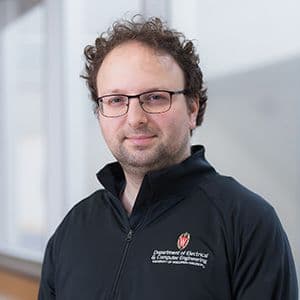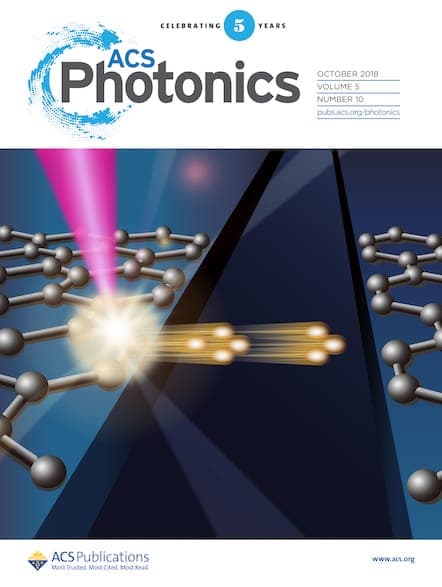Read an exclusive interview with the winner, Mikhail Kats, and learn more about his work and career.

ACS Photonics and SPIE, the international society for optics and photonics, are proud to announce Mikhail Kats of the University of Wisconsin-Madison, as the recipient of the 2026 ACS Photonics Young Investigator Award. This award honors the contributions of an early-career individual who is doing outstanding work in the research areas covered by ACS Photonics.
Mikhail Kats is Jack St. Clair Kilby Professor and Antoine-Bascom Professor at the Department of Electrical and Computer Engineering at the University of Wisconsin-Madison. He received his B.S. in Engineering Physics from Cornell University and his Ph.D. in Applied Physics from Harvard University. He has published about 120 papers in the fields of optical properties of engineered materials, optical metasurfaces, optical and optoelectronic devices, tailoring of thermal radiation and radiative heat transfer, and related topics in optics and photonics.
In 2025, he received the Presidential Early Career Award for Scientists and Engineers (PECASE) and became a fellow of SPIE and Optica. He has previously been identified as a Highly Cited Researcher by Clarivate Analytics (Web of Science), and has received the IEEE Nanotechnology Council Early Career Award, IEEE Photonics Society Young Investigator Award, Air Force Office of Scientific Research (AFOSR) Young Investigator Award, Office of Naval Research (ONR) Young Investigator Award, and the NSF CAREER Award. In addition to research accolades, he has been recognized as an educator and mentor, receiving the UW-Madison ECE Outstanding Graduate Student Mentor Award and being highlighted on the American Society of Engineering Education (ASEE) Prism “20 Under 40” list.

Read the Interview with Mikhail Kats
What does this award mean to you?
I am honored to receive this award from SPIE and ACS—two organizations that have played a major role in my professional career. I’ve been publishing in ACS journals and attending SPIE conferences from my first few years in grad school. In fact, as I am writing these answers, I just returned from the SPIE Defense + Commercial Sensing conference.
I am thankful for the award, which belongs to former and current members of my research group and the many collaborators I have had over the years. I have found the optics and photonics community to be warm and welcoming and it’s a pleasure to work with students, postdocs, and other collaborators from around the world to push the frontiers of science and technology.
How would you describe your research to someone outside your field?
We investigate and engineer the interactions between light and optical materials, often in the infrared spectral range. Though I am not a materials scientist, I am highly motivated to study the optical properties of both emerging and well-worn materials, because understanding of these optical properties can enable new optical physics and new optical and optoelectronic devices. For example, we have been engineering and using phase-transition materials, which can be switched from insulating to metallic states, to make dynamic optical components such as optical limiters, tunable filters, thermal radiators, and modulators.
Another important theme in our work is thermal radiation, which is the emission of light from hot objects. We have used thermal radiation to design a new type of spectrometer, to measure the temperature of objects underneath their surface, and to cool surfaces and help extract water from the air. We have also engineered thermal radiation to conceal information from infrared cameras and imagers. And we design artificial materials and surfaces, dubbed metamaterials and metasurfaces, the latter of which have enabled optical components that are hundreds of times thinner than a human hair, but in some instances can even outperform conventional refractive or diffractive optics. Today, we design metasurfaces for applications as diverse as trapping of cold atoms, interfacing with quantum defects in semiconductors, and night vision.
What inspired you to pursue your area of research?
I think for most people, the research area is not a conscious choice, but instead is selected by a confluence of events and experiences. As a college freshman, I took a course on lasers & photonics (because how could I say no to a class with “lasers” in the title), which was the first time I had the opportunity to do lab work with lasers, custom microscopes, and other optical components. That class encouraged me to change majors from computer sciences to engineering physics. Mid-way through college at Cornell, I reached out to Farhan Rana, whose research group had a cool website. I was fortunate that Farhan took me on, and in his group I had the opportunity to work on semiconductor amplifiers, including both table-top optics and some microfabrication in the Cornell cleanroom. It was a lot of fun, especially working day-to-day with my mentor, then-Ph.D. student Faisal Ahmad. When I was graduating, I wanted to continue to do academic research, and found my way to Federico Capasso’s group at Harvard, where I first worked on plasmonics, and where we developed structures to shape the flow of light at an interface, which today are referred to as optical metasurfaces.
My independent research program at UW-Madison has many imprints from this earlier training I received during my B.S. and Ph.D. degrees, but I am a restless scientist—and today my students and I work on a very broad range of research topics, ranging from to atomic experiments to light sails for interstellar travel to the structural colors in mollusks and beetles.
What exciting advances in your field do you anticipate in the next ten years?
I am in general bad at predictions, especially when they involve the future, but I can try.
I think that automated design of complex optical components, for example metasurfaces and diffractive optics, will become mainstream based on a combination of optimization techniques and AI. I also suspect that we will crack the problem of making small, low-energy, tunable optical components, such that we get paper-thin optical elements that can zoom, focus, or steer light. More generally, optical sensors should keep getting less expensive and more capable: I can easily imagine multispectral imaging, thermal imaging, and Raman spectroscopy on phones, drones, and other gadgets.
What would your advice be to someone just starting out in the field?
I recommend finding as many opportunities as possible to tinker, especially if you can do that as part of a community. Buy some old instruments and components on eBay, and build. Get access to a 3D printer, a laser cutter, a CNC mill. Tear apart an old phone. These experiences will be invaluable: they will both teach you about how things work, but they will also take away your fear in the future, when you may have to build experiments from components that are much more expensive, and where people will be relying on you to get things done right and fast.
